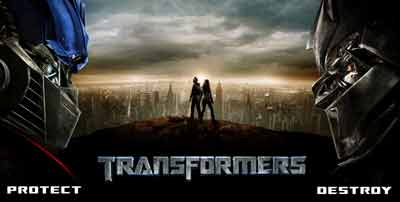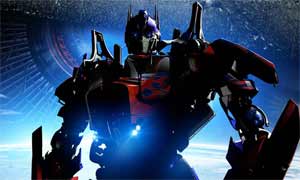
| Bad Astronomy |
|
|
|
BA Blog
|
|
Q & BA
|
|
Bulletin Board
|
| Media |
|
|
|
Bitesize Astronomy
|
|
Bad Astro Store
|
|
Mad Science
|
|
Fun Stuff
|
| Site Info |
|
|
|
Links
|
| RELATED SITES |
| - Universe Today |
| - APOD |
| - The Nine Planets |
| - Mystery Investigators |
| - Slacker Astronomy |
| - Skepticality |
Buy My Stuff

Keep Bad Astronomy close to your heart, and help make me
filthy rich. Hey, it's either this or one of those really
irritating PayPal donation buttons here.
Review: Transformers

Introduction
As an astronomer of a certain age, I just missed out on the Transformer craze of the 1980s (though many other 80s fads smacked me right in the face... Deborah Foreman, wherever you are, I still love you). Maybe it's for the best: that way, I could sit through a Transformers movie without getting all whiny about how it doesn't conform to the endless commercials that assaulted pre-teen boys all those years ago.However, it is a Michael Bay movie, which means that Dramamine is required -- he has never filmed a scene that he felt couldn't be improved by constantly panning the camera around an actor in circles -- and which also means your upper level brain functions are not required.
Having said all that, here's the bottom line: plot-wise, this is pretty much what you'd expect from a Michael Bay movie released on the 4th of July weekend that's about giant robots from space that battle each other and befriend a lone geek who is able to eventually win over the supernaturally hot girl. However, special-effects-wise this movie totally and absolutely ROCKS. It was amazing. And I have to admit, much of the movie made me laugh. Shia LaBeof is really, really funny and talented, and I hope he makes lots more movies.
Now, duh, I understand this is a movie about giant battling transforming robots from space and is based on a bunch of toys (when the credits at the beginning said "In Association With Hasbro" a bunch of people -- yeah, including me -- in the audience snickered loudly), so the science is maybe not going to be at its peak. Still, there were a few things I want to point out, because they're fun to think about. So, on to my My Bad Astronomy Review Where There is More Than Meets The Eye.
MILD SPOILERS AHEAD!
The Review
Bad:When the sooper-sekrit government agency (isn't that always the case?) guy is briefing to the Secretary of Defense about the alien robots, he mentions the Beagle 2 Mars probe, saying it was built by JPL and NASA.
Good:
Um, not to split hairs or anything, but the
Beagle 2
was part of the
Mars Express probe, sent to the red planet by the European Space
Agency and not NASA.
That's a really bizarre mistake to make! They got the name of the lander right, but screwed up on who sent it? It's like they went out of their way to get this wrong (why add JPL to the mix otherwise?). I know, this is a nitpick, but I laughed when they said it.
 Bad:
Bad:
We see Megatron, the Big Bad Guy, frozen in a sooper-sekrit government,
uh, sooper-sekrit room. The head of the agency says that it fell
to Earth in the 1930s, and that the Earth's gravitational field
at the North Pole screwed
up his telemetry, causing Megatron to lose his bearings and
fall to the ice.
Good:
It was really clear from the context of this line that he meant the
Earth's magnetic field, not gravitational field. SciFi movies
make this mistake all the time, confusing gravity and magnetism.
Didn't these guys ever take 6th grade science? Oh wait--
it's a Michael Bay movie. Sorry, silly me. I forgot.
Update (July 7, 2007): I have just learned that the original screenplay was by John Rogers, who in fact has a degree in physics. I'm guessin' the Beagle 2 thing was after he handed it off to the bevy of other writers. BTW, do yourself a favor and click that link. If more movies were written like his blog, I'd see more movies. Of course, they'd never get made, but that's a different problem.
And c'mon, the Earth's magnetic field is pretty puny. We have spacecraft that operate inside the strongest parts of the field all the time, and the magnetism alone can only barely move a needle in a compass.
Now, I'll note that in space, satellites do have be protected from radiation, which is created in part by the Earth's magnetic field. The Earth's magfield collects subatomic particles from the solar wind and accelerates them. When they hit metal, they generate X-rays which can fry electronics. In that sense, maybe Megatron was damaged...
... except they made a big point out of how the alien robots were
radioactive (they use a Geiger counter several times in the movie).
If they were radioactive, then they must already be protected against
the exact kind of problems they'd face in the Earth's magnetic field. Sigh.
Once again, a movie goes out of its way to not only screw up the science,
but
And lest you call me too nitpicky, how about this: if they knew
all along that Megatron was susceptible to radiation, why not use it
as a weapon against him? Instead, they use high-temperature shells,
when it takes a bazillion of them to even slow him down.
Good:
There's one scene where Our Hero is being held by Optimus
Prime, the good robot leader, and they fall at least twenty stories
off a building. After they hit the ground, Optimus opens his
hand and Our Hero walks out. In reality, Our Hero would
actually ooze out. Or maybe leak out.
The only way to safely land after a long fall is to be decelerated
slowly. Well, relatively slowly. That's what air bags in cars do;
they slow your deceleration enough that your head doesn't turn into a
balloon full of goo. So for this to really work, the robots
would have to move their hand downward to match speed with the falling
victim, and then slow their hand to reduce the impact velocity.
They came close to this in one scene, where a robot moves his hand around
in a curving motion, indicating that the vertical motion is transformed
(haha) into horizontal motion. That might work if it's done correctly,
but moving horizontally doesn't help at all; horizontal and vertical
motion in a fall are independent. It doesn't matter how fast you
are moving to the side, you'll impact at the same vertical speed.
It's a common misconception that moving sideways helps. It doesn't.
Good:
Driving this point home, the object of the robots' desire is an enormous
metal cube, maybe 30 meters on a side. Its vast weight is obvious from
the way it's supported in the sooper-sekrit chamber (OK, OK, I'll stop with
that stuff). Yet it gets transformed down into a cube only a foot across,
and Our Hero is able to not only pick it up and carry it, but run long
distances with it (and dagnappit they established in the movie that he was a
sports weenie, yet he can run dozens of city blocks without even panting;
why oh why does Bay go so far out of his way to to do stupid stuff
like that in movies when it's so easy to fix?).
Maybe the robots have some sort of device which can reduce the
mass of an object and themselves at will. But then maybe Megatron
(and the good robots later in the movie)
could've used that ability when he crash landed on Earth; if he
had reduced his mass to that of a snowflake he would have gently
drifted to the ground instead of slamming into it like a meteor.
Movies make this mistake all the time; every "shrink people so
they can go inside other people" movie does this (at least in
the book version of "Fantastic Voyage" this was accounted
for using quantum mechanics, but then that was written
by noted author and scientist himself Isaac Asimov).
Just once I'd like to see some car get hit by a shrink ray, and when
it becomes matchbox size it suddenly falls through the surface of the Earth
because its density goes up to several tons per cubic inch. That
would be really cool. And funny.
 Bad:
Bad:
In several scenes, people fall long distances and are caught
by a robot at the
last second before they hit the ground.
It doesn't matter if you hit the ground or a robot's hand,
if you fall hundreds of feet (or even a lot less), you'll
get squished if you are suddenly stopped. Like the saying
goes, it's not the fall that kills you, it's the impact.
 Bad:
Bad:
In many many scenes, it's indicated that the robots are really
massive. We see them slamming into the ground making craters,
there is a loud thump when they walk, and at one point their
motion makes a character think an earthquake is occurring.
But when they fold up into cars (trucks, helicopters, whatever)
they take on the weight of that object.
When you take an object and shrink it,
the weight stays the same. Instead of a small, lightweight
object, when a robot transforms back into a car you'd get a small,
incredibly dense and heavy object. I'd guess a big robot would
weigh 10 - 20 tons or so. Convert that into a car and blown tires is
the least of your problems. Drive over a bridge and see what happens!
Conclusion
Surprisingly, that's about it. There were lots of other little things,
but nothing I remember worth noting.
Despite my science review, I really do recommend seeing this movie
since it was a lot of fun and the special effects were truly awesome.
It's a dumb movie, don't get me wrong, but there is room in the
world for dumb movies sometimes.
Links
|
|
 |